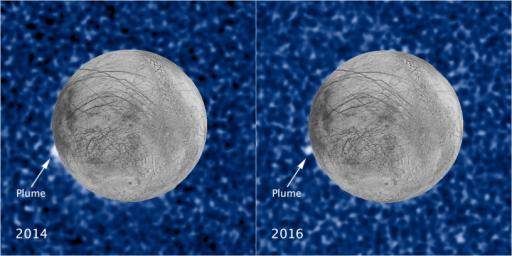
|
Hubble Sees Recurring Plume Erupting From Europa
- Click the image above for a larger view
- Full-Res JPEG (1235 x 618) (118.6 kB)
- Full-Res TIFF (1235 x 618) (1.3 MB)
Caption:
These composite images show a suspected plume of material erupting two years apart from the same location on Jupiter's icy moon Europa. The images bolster evidence that the plumes are a real phenomenon, flaring up intermittently in the same region on the satellite. Both plumes, photographed in ultraviolet light by NASA's Hubble's Space Telescope Imaging Spectrograph, were seen in silhouette as the moon passed in front of Jupiter.
The newly imaged plume, shown at right, rises about 62 miles (100 kilometers) above Europa's frozen surface. The image was taken Feb. 22, 2016. The plume in the image at left, observed by Hubble on March 17, 2014, originates from the same location. It is estimated to be about 30 miles (50 kilometers) high. The snapshot of Europa, superimposed on the Hubble image, was assembled from data from NASA's Galileo mission to Jupiter.
The plumes correspond to the location of an unusually warm spot on the moon's icy crust, seen in the late 1990s by the Galileo spacecraft (see PIA21444 ). Researchers speculate that this might be circumstantial evidence for water venting from the moon's subsurface. The material could be associated with the global ocean that is believed to be present beneath the frozen crust.
Cataloging Keywords:
| Name | Value | Additional Values |
|---|---|---|
| Target | Europa | Jupiter |
| System | Jupiter | |
| Target Type | Satellite | Planet |
| Mission | Galileo | Hubble Space Telescope (HST) |
| Instrument Host | Galileo Orbiter | Hubble Space Telescope |
| Host Type | Orbiter | Space Telescope |
| Instrument | ||
| Detector | ||
| Extra Keywords | Color, Plume, Ultraviolet, Water | |
| Acquisition Date | ||
| Release Date | 2017-04-13 | |
| Date in Caption | 2014-03-17 | 2016-02-22 |
| Image Credit | NASA/ESA/W. Sparks (STScI)/USGS Astrogeology Science Center | |
| Source | photojournal.jpl.nasa.gov/catalog/PIA21443 | |
| Identifier | PIA21443 | |
